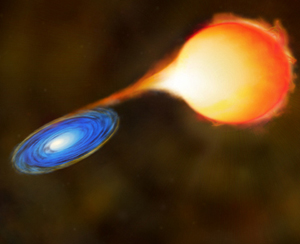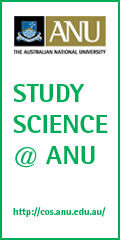 |
|
An
artist's conception of the Mira binary star system, showing material
from Mira A being drawn into a disc around its smaller companion, Mira
B. Image: CXC/M.Weiss |
SYDNEY: The formation of what could be a new class of planetary system has been observed by an international team of astronomers.
The team, which reported their findings at the most recent meeting of the American Astronomical Society, used powerful telescopes to examine Mira, a binary star system about 350 light years away. They observed material from the dying red giant, Mira A, being siphoned off and captured in a disc around its smaller companion, Mira B – the first step in the creation of a planetary system.
“When looking at one of the most celebrated and well-studied stars in the galaxy, I was amazed to find something new and unexpected,” said co-author Michael Ireland of the California Institute of Technology in Pasadena.
The findings are particularly exciting, said the researchers, as astronomers have traditionally assumed that the dusty discs where planets form are only found around young stars in 'stellar nurseries'. This is the first time that a ‘protoplanetary disc’ has been found in the environment of a dying star.
“The discovery not only changes the way we think about a star that’s important historically, but also how we’ll look at similar stars in the future,” said Irelend. “[It] opens up new ways to search for new planets, by searching in double star systems that contain white dwarfs.
"Astronomers associate the death of a star with the death of its planetary system. Here, the opposite is happening, with an ageing star laying the foundation for a new generation of planets.”
Mira A, located in the constellation Cetus, was first observed about 400 years ago. Its companion, Mira B, was first discerned by the Hubble Space Telescope in the 1990s. Mira constantly changes brightness, and is visible to the naked eye for about a month at a time, reappearing on an 11 month cycle.
The red giant, which was once very similar to our Sun, is now dying, losing its dusty outer layer at a rate of around one Earth mass every seven years. The researchers have calculated that around one per cent of this material is being captured in the gravitational field of its companion star, Mira B.
The protoplanetary disc was observed at the 10 metre Keck I telescope on Mauna Kea, on the Big Island of Hawaii, and at the eight metre Gemini South telescope in Chile. The pictures, made using new imaging techniques, revealed details that were thought to be impossible to detect due to the blurring caused by atmospheric turbulence.
Using the new techniques, the researchers were also able to determine that Mira B, long thought to be a white dwarf, is simply a less massive version of our own Sun.
The intense radiation from Mira A, which is 5,000 times brighter than the Sun, heats the edge of the disc to about Earth’s temperature and causes it to glow in the infrared. The researchers were able to show that the material was indeed the edge of a disc and not just a clump in the ‘wind’ of particles blowing off Mira A.
According to co-author Peter Tuthill of the University of Sydney in Australia, “Observing Mira in the infrared is like staring straight down the barrel of one of the brightest searchlights in the galaxy. It came as a real revelation to see this faint mote of dust, harbouring all the new possibilities of new worlds in formation, against the hostile environment of the red giant.”





